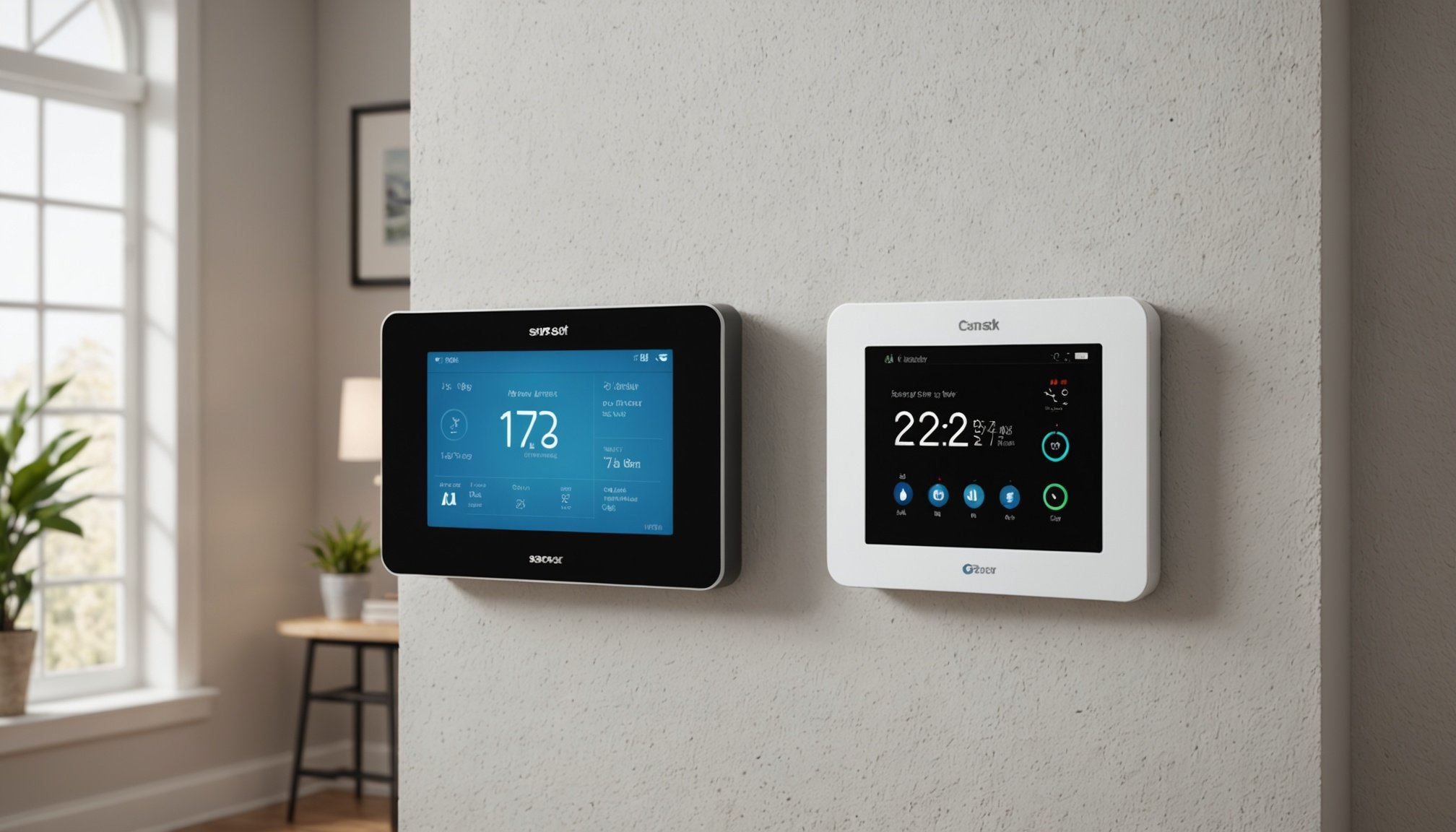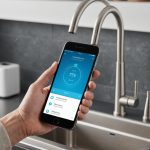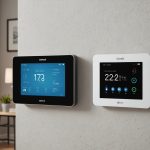Understanding Smart HVAC Systems
Smart HVAC systems are transforming the way we control our indoor environments. These systems utilise advanced technology features to automate and optimise indoor climate control. By integrating smart sensors and learning algorithms, they enable precise management of heating, ventilation, and air conditioning based on real-time data.
Key features of smart HVAC systems that enhance their functionality include:
In the same genre : Revolutionize Your Water Filtration: Seamless Smartphone Control for a Smarter Home
- Remote Access: Allowing users to control the system from anywhere via smartphone apps, offering convenience and adaptability.
- Energy Efficiency: These systems often include energy-saving modes that learn your schedule and adjust settings to optimise energy use, leading to lower utility bills.
- Intelligent Thermostats: These can adapt heating and cooling cycles to maintain comfortable temperatures while reducing energy waste.
How do smart HVAC systems contribute to energy efficiency? They continuously adjust settings based on sensory input, such as occupancy and weather data, thus optimising energy use. This results in significant cost savings while maintaining optimal comfort levels. Users often report a notable reduction in energy consumption, thanks to precise indoor climate control solutions.
Embracing smart HVAC not only enhances comfort but also supports environmentally friendly living through efficient energy usage. As technology advances, these systems will likely become even more integral to sustainable home and building management.
This might interest you : Elevate Your Smart Home Experience: Effortlessly Control Appliances with Your Smartphone and Voice Commands
Benefits of Seamless Indoor Climate Management
Indoor climate management plays a crucial role in enhancing both comfort and well-being. Smart HVAC systems shine in this area by offering responsive and precise control over the home’s environment. By constantly monitoring variables such as temperature, humidity, and occupancy, these systems ensure optimal conditions are maintained effortlessly.
Enhanced comfort levels are a direct result of this vigilant monitoring. With temperature adjustments made in real-time, users experience consistent comfort without the need for manual intervention. Imagine a system that seamlessly cools your home during a heatwave or provides warmth on a chilly evening, all autonomously.
Besides comfort, significant energy savings are achieved through energy-efficient practices embedded in smart HVAC systems. By intelligently adjusting settings based on actual needs rather than static schedules, these systems cut unnecessary energy usage. The impact on utility bills is after often substantial, leading to long-term financial benefits.
A well-managed indoor climate not only enhances comfort but also positively affects health and productivity. By maintaining optimal air quality and consistent temperature levels, individuals can enjoy healthier living conditions and improved focus on work-related tasks. Therefore, smart HVAC systems stand as a testament to the harmony between technology and daily living, fulfilling human needs while conserving resources.
Installing Smart HVAC Systems
Implementing smart HVAC systems is an exciting step towards a more connected home. The process often starts with identifying the right equipment, ensuring compatibility with existing home infrastructure. Selecting a system that allows for seamless integration with your home automation platforms can vastly improve the user experience and overall efficiency.
Setup Process
The installation typically involves several key phases:
- Evaluation: Assess your current HVAC system and determine if any upgrades or replacements are required.
- Selection: Choose a smart system compatible with your existing setup or new requirements.
- Installation: Technical installation is usually carried out by professionals to ensure all components are correctly configured and functioning.
Once installed, integrating your smart HVAC with other home automation systems can enhance functionality. It allows synchronization with devices such as smart lights or security systems for a unified control experience.
While the installation is generally straightforward, challenges such as network connectivity issues or hardware compatibility may arise. These can often be mitigated by consulting with technicians or referring to the system’s guidance documentation during setup. Addressing issues proactively ensures smooth operation and maximizes the benefits of your smart HVAC system.
Usage and Management of Smart HVAC Systems
Smart HVAC systems bring a sophisticated edge to system management with their intuitive user interfaces. One of the standout features is the ability to remotely control these systems through smartphone apps. This function is not just about convenience but maximises user engagement by allowing climate adjustments from virtually anywhere. Imagine adjusting your home’s temperature while you’re still at work, ensuring your arrival to optimal comfort.
Furthermore, remote access facilitates easier management of HVAC settings, benefiting those with unpredictable schedules. Another notable feature is the scheduling and automation capabilities. These systems can be programmed to tailor specific heating and cooling cycles to match your lifestyle, leading to significant energy savings by minimising unnecessary operation times.
In addition to these user-friendly features, the interface often includes real-time data monitoring and analysis, providing users with clear insights into their energy consumption patterns. This enables more informed decisions regarding energy usage and cost management. The integration of smart learning algorithms means these systems don’t just follow commands but evolve with usage patterns, optimising comfort and efficiency effortlessly.
Collectively, these technology features revolutionise how indoor climate control is approached, making the management of smart HVAC systems both simple and effective.
Troubleshooting Common Issues
Smart HVAC systems, while innovative, can sometimes face technical issues. A common hurdle is network connectivity problems, often caused by weak Wi-Fi signals or router settings. To address this, ensure your smart HVAC system is within range of your router and that there are no interferences from other devices. Adjusting router settings or using Wi-Fi extenders can improve connectivity.
Another issue involves sensor malfunctions, leading to inaccurate temperature readings. In such cases, inspect sensors for dust or obstructions and clean them if necessary. If the problem persists, recalibration or replacement might be needed.
DIY troubleshooting steps can resolve many problems. Begin by checking the user manual for guidance on resetting the system, which often resolves software glitches. Inspect wiring and connections if your system fails to operate, ensuring there are no loose or damaged parts.
However, certain issues may require professional assistance. If there are persistent malfunctions or complex technical challenges, it’s prudent to consult an HVAC technician. They possess the expertise to diagnose and fix intricate problems efficiently, ensuring your system operates optimally again.
Understanding these common issues and knowing when to seek professional help can save time and prevent further damage, enhancing the longevity and efficiency of your smart HVAC system.
User Reviews and Case Studies
To fully appreciate the impact of smart HVAC systems, exploring user testimonials and case studies can be enlightening. Many homeowners praise these systems for their transformative effect on indoor climate control. One standout feature frequently highlighted is the automation of heating and cooling cycles, which allows for precise adjustments without constant manual input.
Real-world experiences reveal a significant boost in both energy efficiency and comfort levels. For instance, a case study demonstrated how integrating a smart system led to a 20% reduction in energy bills over a year. Such savings arise from the system’s ability to adapt to user routines and optimally manage resources based on real-time data, underscoring the seamless technology features at play.
Testimonials often mention the convenience and flexibility provided by these setups. Users appreciate the capability to monitor and adjust settings remotely via their smartphones, ensuring perfect indoor climates regardless of their location. These systems not only promise hassle-free, intuitive management but also contribute to a greener environment through responsible energy consumption.
Ultimately, these user reviews and case studies illustrate a bridge between cutting-edge technology features and practical everyday applications, making smart HVAC systems a compelling choice for modern homes.











